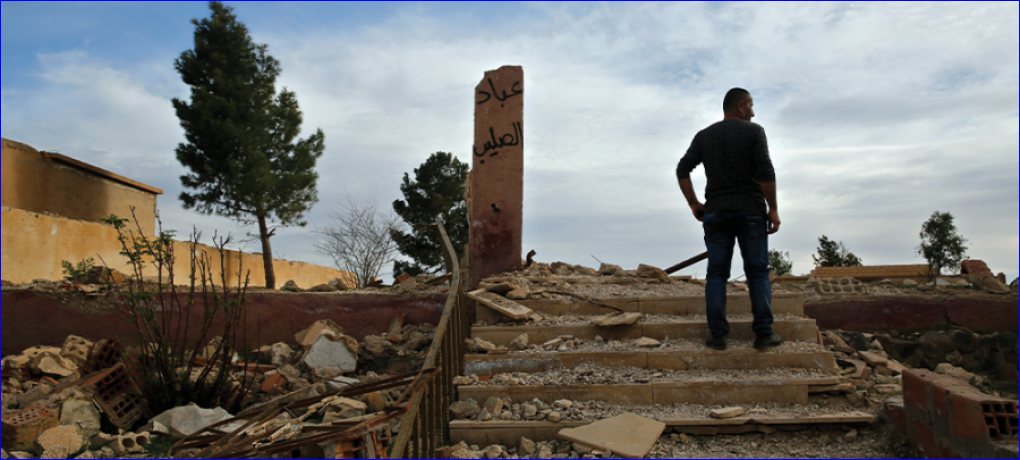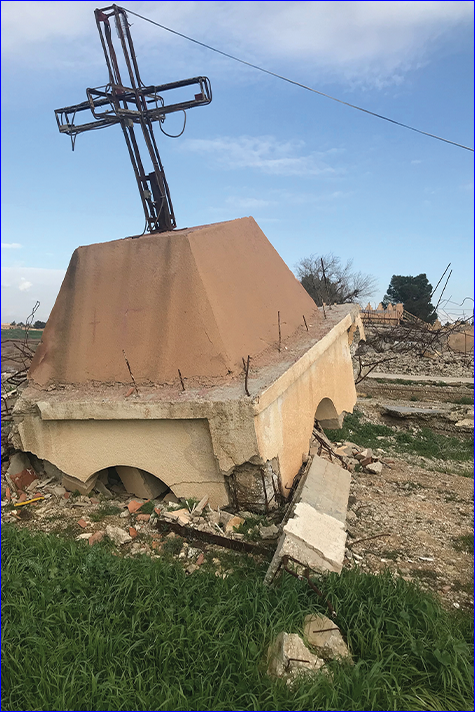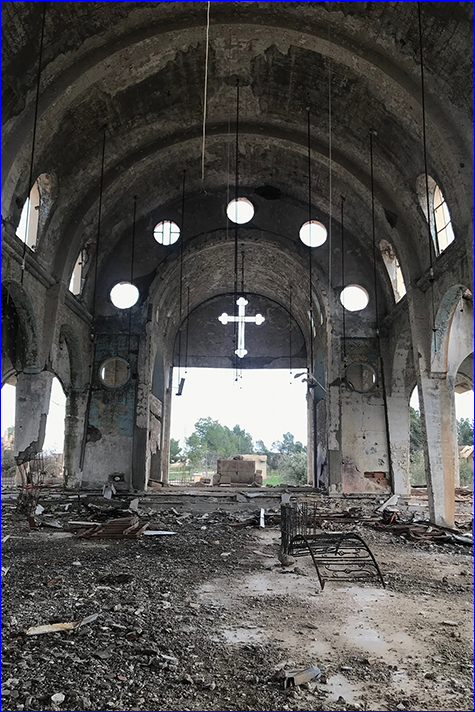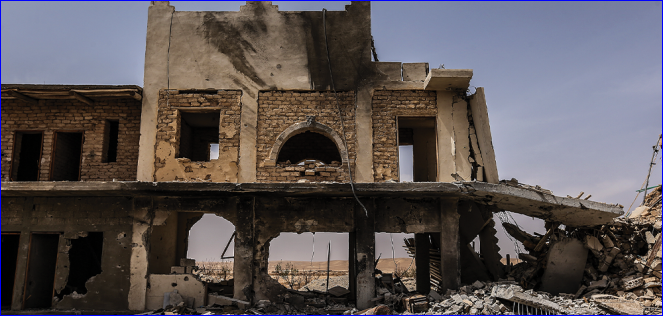


 Hussein Malla/AP)
Hussein Malla/AP)
Near the entrance to the village of Tel Hormizd, a bombed-out water tower, lying sideways near the riverbank, signals visitors that this is no rural idyll. ISIS fighters destroyed the tank when they captured this area in 2015, and no one has returned to repair it or a vast landscape of surrounding destruction.
Four years ago--on Feb. 23, 2015--ISIS militants overran the 30 villages that make up this valley. They bombed and destroyed 12 churches, multiple homes, and structures like the water tower. The fighters kidnapped more than 250 Assyrian Christians and drove away thousands of residents. Seven months later, they dressed three captured residents from the Khabur villages in orange jumpsuits, then videotaped their execution.
Not long ago there were 20,000 Assyrian Christians living in the Khabur River Valley, said Mar Afram Athneil, the Assyrian Church of the East bishop of Syria: "Now we have less than 800."
The civilian atrocities of Khabur are but one episode in a Syrian War that's left at least 500,000 people dead and much of the country in ruin. But the targeting of a stubborn Christian population--mirroring how ISIS sought out, threatened, and destroyed Christian communities in Mosul and its surrounding villages in Iraq--has become emblematic of what many Christians fear may be their future in the Middle East.
Related: Timeline of ISIS in Iraq
Related: Attacks on Assyrians in Syria By ISIS and Other Muslim Groups
Fierce fighting here has moved east, but security is proving elusive. Many feel betrayed by the unexpected December announcement from President Donald Trump declaring ISIS defeated and a U.S. withdrawal from Syria imminent. The confusion surrounding the U.S. policy shift rattled a fragile non-Muslim population faced with an array of menacing opponents.

 Mindy Belz)
Mindy Belz)
Assyrians were among the first to convert to Christianity, with their churches, their Aramaic Scriptures, and their ancient hymnody (Syrian chant is the forerunner to the better-known Gregorian chant) taking hold between the first and third centuries.
From the world's earliest church sites in Tur Abdin in Turkey, Assyrians spread Christianity across what today are Syria, Iraq, and Iran. Repeatedly threatened by Muslim armies and government authorities, their communities today sit visibly near extinction, even as the Syrian War itself may soon end.
Tel Nasri was a growing village along the Khabur River with about 1,200 residents when it replaced an old and small mud church with a new and expansive building in 2007. The new church included a barrel vault with six windows and two bell towers, each about four stories high with rounded domes, topped by crosses.
ISIS emptied the village in early 2015, fought Khabur Defense Units and Kurdish forces for nearly two months, and on Easter Sunday blew up the church. The debris, including bell towers toppled like playthings, lies scattered among olive groves and vineyards left to grow wild.

 Mindy Belz)
Mindy Belz)
Only four Assyrians have returned to live in Tel Nasri, I learned, yet I couldn't find one to talk to on the February afternoon I visited. In other villages I found handfuls of residents, or completely empty towns.
"It's very easy to rebuild the churches and the houses. We can raise some money and rebuild whatever is needed," said Athneil, "but to create confidence for people to return is much harder. I don't know that we can do that."
Athneil found himself at the center of negotiations with ISIS for the release of his captured parishioners, who ranged in age from 6 months to 90 years old. ISIS tried for weeks prior to the kidnappings to impose on the villages jizya--a tax for non-Muslims--then demanded exorbitant ransoms, exceeding $12 million total. The bishop and others raised an unnamed sum from a worldwide network of displaced Assyrians.
With payments, the militants released the residents in small groups over the next 13 months, starting with the elderly but holding many families with young children for a year or more. ISIS fighters threatened the hostages, holding guns to fathers' heads and demanding they convert to Islam. Early on, they selected five girls to be enslaved as ISIS brides. Four were released, but one of them, now 16 years old, remains in ISIS captivity.

 Valery Sharifulin/TASS via Getty Images)
Valery Sharifulin/TASS via Getty Images)
What ISIS did not destroy outright it has dismantled through such prolonged threats and intimidation, prompting Khabur families plus others to emigrate. I interviewed multiple families, yet few wanted their names to appear in print, still fearful four years after the attack. Kidnap victims stood firm against ISIS demands to convert to Islam, yet as a result their families have been scattered, with relatives in Sweden, Australia, or the United States. It will take more than defeating ISIS militarily to make life for Christians possible here again. It will take specific--and lasting--freedoms and protection.
HOW TO GAIN SUCH PROTECTION has divided Syria's churches. Athneil told me "most of the Christian peoples are pro-regime." They support the government of President Bashar al-Assad because he represents stability and has protected non-Muslims. They believe he will take a hard line against terror groups like ISIS, despite the looming influence of Russia and Iran. Plus, he has regained control of just over half the country. Failing a negotiated settlement requiring a transitional government (called for in the UN Security Council's Resolution 2254 guiding faltering talks), he may retake all of Syria.
But many Christians who have survived the war see an opportunity for pluralism and for religious freedom not allowed under Syria's current constitution. Attacks like that in Khabur Valley bred a fierce determination to secure Assyrian homelands, and for some a new willingness to take up arms against Islamic jihadists.
If Assad remains in power, said Gabriel Moshe, head of the Assyrian Democratic Organization, "there will never be any security, there will never be any settlement. Any terrorist organization can arise again."
Despite epochal clashes with Kurds, Assad opponents are pinning their hopes on a Kurdish-led political and military coalition that controls what for centuries were predominantly Christian areas. The coalition operates a political federation now called the Self-Administration in North and East Syria (SANES), an area of 4 million people extending east of the Euphrates and encompassing Jazira, the ancient homeland for Assyrian and other Christians.
Within the self-administration zone Kurds, Christians, and Arabs have established political leadership and military control over strategic areas liberated from ISIS and other jihadist groups. They have set up a loosely federal structure of local cantons they say are committed to preserving individual freedom, including religious freedom and equal rights for women.
The zone currently protects 100,000 people in historically Christian populations, along with 21,000 new Muslim converts--according to the Syriac National Council, one party in the federation. Aramaic, the first-century language of Christians still used in the ancient churches, is an official language alongside Arabic and Kurdish.
Their control grows out of ground war victories involving the Kurdish YPG/YPJ units, the Assyrian-led Syriac Military Council (MFS), and several Arab militias--all fighting now under the loose banner of the Syrian Democratic Forces (SDF). Their efforts, supported by U.S.-led coalition air power, have reduced ISIS territory to mere patches of land south near Deir Ezzor. The wins have come with a price: More than 14,000 SDF soldiers have died or been wounded in battle. ISIS beheaded captured Yazidi women in Baghuz, one of the group's strongholds, as its fighters fled.
While ISIS as a caliphate may be on the verge of defeat, the war is far from over. Al-Qaeda--linked militants remain in control in Idlib to the west, where fighting and civilian casualties spiked in recent weeks. Turkish-backed militias control Afrin in the northwest, an area now cut off from the rest of Syria, with tens of thousands of mostly Christian and Kurdish residents displaced from there. Turkey invaded that area last year, seeking what it called a safe zone to defend itself against Kurdish militias. Turkish forces occupy up to 40 miles of territory inside Syria near Afrin and continue in a tense standoff with Russian forces backing the Syrian army of President Bashar al-Assad.
What does it all mean for the Christians in Jazira? On every side they confront potentially hostile forces, particularly if they remain opposed to the Assad regime, and especially if the United States cuts ties.
Leaders in the self-administration zone joined about 40 U.S. religious freedom and human rights groups in a January letter to President Donald Trump, protesting the planned U.S. withdrawal. Such a decision, they said, "breaks commitments our government made to protect the area and support its democratic aspirations." The groups also warned of genocidal threats and war crimes, not only by ISIS but also Turkey and the jihadist militias it supports.
"Most ethnic Christians now living in the [self-administration zone] are descendants of people driven out of Turkey 100 years ago by the Armenian and Assyrian Genocides. They are terrified," they wrote.
Ilham Ahmed, co-chair of the Syrian Democratic Council, delivered a similar message when she visited Washington to meet top officials in February. Following those meetings, the top U.S. commander in the Middle East, Gen. Joseph Votel, traveled to northern Syria and met with the commander of the Syrian Democratic Forces--an hourlong meeting and a symbolic show of support.
In a reversal on Feb. 23, the Pentagon announced the president had ordered 400 troops to remain in Syria as part of a multinational force.
Already the United States has withdrawn some heavy equipment from its base at Manbij, and in coming weeks may continue to draw down military personnel from the current level of almost 2,000. At the Munich Security Conference, Vice President Mike Pence told world leaders a Syria withdrawal represented "a change in tactics, not a change in mission."
SDF leaders hope an incremental withdrawal is preceded by enhanced U.S. air coverage for northern Syria to hold the hard-won territory and fledgling steps to democracy.
WITH WAR THE CHRISTIAN POPULATION throughout the country has plummeted--from about 8 percent in 2011 to 2 or 3 percent of the population today. Attrition has come through targeted killings, kidnappings, and emigration.
Besides the Khabur attacks, ISIS struck multiple Christian targets and took hundreds hostage in the mostly Christian city of Qaryatayn. Most remain unaccounted for. Nearby, militants blew up the 1,500-year-old Mar Elian monastery and held hostage for five months its prior, Syriac Catholic priest Jacques Mourad. He lives in Europe now, and the city sits mostly empty, its houses destroyed by ISIS.
At the same time, war and displacement have a way of feeding the church, too. Some churches in the north are starting or growing, fueled mostly by conversions of Kurdish Muslims. In Kobani, a church of Christians displaced from Afrin is drawing converts. It has 50 families and is growing.
In the Shahba canton near Aleppo, also part of the self-administration zone, the first church in the area is growing out of 5,000 displaced people from Afrin forced to take refuge there. They receive humanitarian aid from other churches, and workers say many among the displaced are coming to faith in Christ.
Even in the Khabur Valley, heartening signs of life can appear. Elias Antar, 72, has returned with his wife Shamiram to live in Tel Hormizd. He said they were among the last to be kidnapped by ISIS and the first to return. Too impatient to wait for demining teams after Kurdish YPG and local Khabur Defense Units kicked out ISIS, "we checked for mines ourselves and risked our lives to come back."
Antar, an Assyrian Christian, has become a kind of spokesman for the Khabur villages, reaching out to Assyrian families who fled after Feb. 23, 2015, and needling them to return. "We challenge all those who are running away by growing things while they are hunting for work," he said. "We have sheep, bees, olive trees, and grapes."
Antar convinced two Assyrian-Americans to come back and persuaded residents from nearby cities Hasakah and Qameshli to make regular trips to work on the village. As we talked, several families picked greens in a field near his home. Up the lane a boy herded sheep from their pen, and a young woman shooed chickens.
Four hundred people lived in Tel Hormizd when ISIS attacked, Antar said. And now? I ask. He paused, then said, "Maybe 15. Twelve or 15."
At the other end of the village, up winding streets lined with houses pockmarked by bullets and gutted by fire, the village church overlooks the river and the town, or at least it used to. ISIS completely leveled the building. Only a flat space of flooring remains, where residents sometimes bring chairs for informal worship services. The church's bell tower is toppled to the ground but still rings.
We talked and drank tea in the airy home Antar was born and grew up in, the windows opened toward the river. When its banks overran with wavy grass in the spring, families from throughout Jazira once came for picnics. Cotton and wheat were the staple crops, and many families raised livestock and grew olive, apricot, and plum trees. Some breadwinners worked in cities like Hasakah or Qameshli by day but farmed also.
The Khabur is the largest tributary of the Euphrates--rich in ancient lore and mentioned in the writings of the Greeks, the Romans, the Persians, and the author of 1 Chronicles. Khabur is the site where the ancient Assyrian king Tiglath-Pileser III once exiled Hebrew tribes, including the Reubenites, the Gadites, and the half-tribe of Manasseh.
The most recent forced exile to Khabur was in the 1930s, when the League of Nations deeded "strips of land twenty-five miles long and over three miles wide on both sides of the river" to Assyrian families who endured multiple 20th-century massacres.
The families who moved here had survived the Armenian genocide under the Ottoman Empire, when the Turks massacred an estimated 300,000 Assyrians alongside more than a million Armenians. The Assyrians then survived an armed campaign by Arabs and Kurds in Iraq.
The trek of Antar's parents was typical for the Assyrian refugees. "My father was displaced from Hakkari in Turkey to Iran, then to Russia, then to Greece, then to Lebanon, to Iraq, and finally to Syria." He met his wife, also a refugee, in Iran.
"They moved in groups then, not scattered like now," Antar said. "With ISIS, we simply have flown."
Of seven children, Antar's eldest son lives in Ukraine, while two sons live in Tel Hormizd. Four married daughters all have emigrated since the attacks, two living in Germany and two in Australia.
"It's difficult to be here, but we accept the hardship," he told me. "We work and have activities. This is my life and I have no empty time. I was born in this village in 1946. And I will die here."

or register to post a comment.